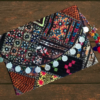Kalamkari is an ancient art form that originated in India and has been practiced for over 3,000 years. Kalamkari dupattas have gained popularity not only in India but also internationally, as they showcase the rich heritage and craftsmanship of Indian textiles. They are often sought after by art enthusiasts, fashion connoisseurs, and those who appreciate traditional handcrafted items.
Kalamkari has a rich history that dates back to the Indus Valley Civilization, and it has been practiced in various parts of India, such as Andhra Pradesh, Telangana, and Tamil Nadu, for centuries. Kalamkari was traditionally used to create intricate designs and motifs on cotton and silk fabric, which were then used to make clothing, wall hangings, and other decorative items.
The word “Kalamkari” is derived from two Persian words: “kalam” meaning pen and “kari” meaning work. The art form involves hand-painting or block-printing intricate designs onto cotton or silk fabrics using a pen or a block.
The Kalamkari art form can be divided into two types: Srikalahasti style and Machilipatnam style. The Srikalahasti style is known for its intricate pen work and the Machilipatnam style is known for its block-printing technique.
The process of making Kalamkari involves several steps, including preparing the fabric by washing and bleaching it, outlining the design using a pen, and then filling in the design with colors made from natural dyes such as indigo, turmeric, pomegranate, and madder. The fabric is then washed again to remove any excess dye and to set the colors.
The designs used in Kalamkari are often inspired by Hindu mythology, nature, and the everyday lives of people. Some common motifs include peacocks, lotuses, elephants, and geometric patterns.
Kalamkari is not just limited to fabrics, it can also be used to create paintings and wall hangings. These art pieces can be found in temples and museums across India.
Penkalamkari is a specific type of Kalamkari art that is practiced in the Indian state of Andhra Pradesh. It is a variation of the traditional Kalamkari art form, which involves hand-drawing and painting intricate designs on fabric using a kalam (pen) and natural dyes. Penkalamkari is characterized by its vibrant colors, bold designs, and intricate detailing. Unlike traditional Kalamkari, which often features muted colors and fine lines, Penkalamkari employs a wider color palette and thicker lines to create bold and striking designs.
In recent years, Kalamkari has gained popularity around the world for its unique and intricate designs. Today, Kalamkari art is appreciated all over the world for its beauty, craftsmanship, and cultural significance. Kalamkari products such as sarees, dupattas, and wall hangings are highly sought after, both for their aesthetic appeal and for their connection to India’s rich cultural heritage. It has been used to create a variety of products, including sarees, dupattas, bedspreads, and curtains.
The Kalamkari art form is not only visually stunning, but also holds cultural and historical significance. Its unique combination of natural dyes, hand-drawn designs, and intricate motifs make it a valuable part of Indian cultural heritage, and a timeless and elegant addition to any wardrobe or home décor collection. It is a testament to the rich artistic heritage of India and serves as a reminder of the importance of preserving traditional art forms. By supporting and promoting Kalamkari, we can help ensure that this beautiful art form continues to thrive for generations to come.




